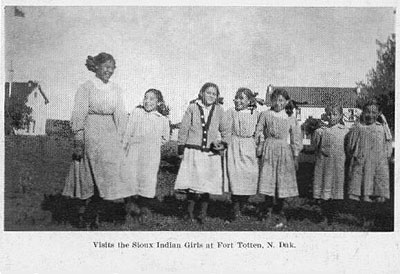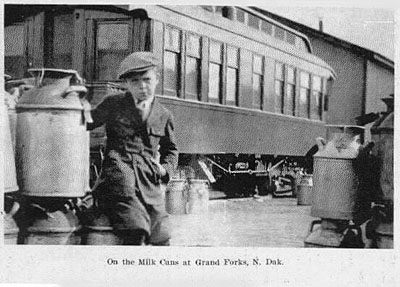CHAPTER II
Ringling Brothers show was in St. Paul and we wanted to go but there were so many things we wanted to do
that we couldn't do them all. Wild rice is good, if it is cooked right,
it is about like eating wheat with the chaff on. It is planted in the
swampy land and in the lakes to get the ducks and geese to light so you
can shoot them. But hunters say it is to feed them. Split pike is the
same as pike split and they are fish called pike and some call them
pickerel; these we had to eat were called wall-eyed pike. They sure
were cooked fine and they were better than trout that we got in the
east. I don't know why they call them wall-eyed unless it is because
they are not. Who ever saw a fish with eyes like a wall? Maybe it is
because walls have windows but then they ought to call these fish
window-fish if that is the reason. The fish-book says the proper name
for them is Stizostedion vitreum so when you want one just catch a pike
or a blue pike or a pickerel or a green pike or a yellow pike or a sand
pike and you will have it.
Bill is nearly as big as his dad and Ed. is bigger than him. We got
mother a pair of rubber heeled shoes so she could walk easy but she
didn't like them because they were too low in the heels and not in
style. Matthews went with us to the store to get them and then showed
us the exhibition of the Great Northern Railroad which was very
interesting.
At 4 o'clock we left for Lake Minnetonka where I took a swim in the
lake but did not have time to go fishing; but there was a fellow came
in with 46 fish on his string all of them about a foot and a half long
and it was all he could carry from the boat. We got supper at the hotel
and they soaked us six dollars for some fresh fish when the lake is
full of them. We went back as far as Minneapolis and wandered around
until mother decided to wait on us at the station. About every business
place was either a shooting gallery or a restaurant, finally we went
into a Moxie I mean a vaudeville show. Dad was tired and he went to
sleep. Our train left at 11 P. M. and I luckily looked at the clock and
it was 10:30. The blocks are very long there and we had to walk. On our
way we risked and stopped to get a sandwich and a glass of buttermilk.
We got there just as he was about closing the gate and just made it and
that was all.
Devil's Lake was the next stop which I am going to tell about. We rode
all night through Minnesota and the next morning I was late for
breakfast but the porter said I could get something to eat at Grand
Forks so I had some flapjacks and orange and dad took a picture of me
on a pile of milk cans. You couldn't say much for North Dakota because
of the plains where you could look out and see if you were there and
see nothing but a clump of trees here and there as far as you could see.
We arrived at Devil's Lake about noon and got a room at the Great
Northern hotel. This hotel was put up by the Great Northern Railroad.
As soon as possible, dad went out to see if he could locate Captain
Heerman an old friend of dad's who used to transport freight and hides
up and down the Mississippi river and the Missouri in days of Mark
Twain. I don't know whether he was acquainted with Huck Finn or not. He
was over at his farm at Fort Totten but was coming home about 3
o'clock. Pretty soon there was a call put in our room. It was Captain
Heerman and he said to come down right away and he started to bring
back old remembrances of the buffalo days.
Captain Heerman is 86 now and he walks every birthday twelve miles from
St. Paul to Minneapolis. They just had a big picnic for him and the
other old river captains at Minneapolis and had his picture in the city
papers about it. He took us over to his house and made us stay for
supper. He told me many stirring stories of the olden days about the
buffaloes.
One of them was of a man in horse and buggy who was stopped by a herd
of them and waited two hours and a half for them to pass and he
measured the width of the tracks where they passed it was two miles and
a half wide. Not making an excuse but hearing it with my own ears it
was true. It happened 41 years ago. He told us about another buffalo
story that happened when he was going up the Missouri river about the
same year. A herd of buffalo came to the river to cross and were so
many of them that he had to stop his steamboat for one hour while the
buffalo swam over and got out of his way. He said while they were
swimming close in front of the steamboat the passengers were all out
watching the great sight and someone wanted them to catch one with a
lasso, so the men who worked on the boat got a rope and made a loop and
threw it over the horns of a big one then they all got hold of the rope
but they could not hold him. So the captain told them to take a hitch
onto the steam windlass and he rung the engineer to wind him up on the
deck and up he came all wet and struggling and when they swung him over
on the deck they had to cut his throat and skin him on the boat deck.
There was a great scattering of the passengers when the old fellow was
butchered there for fresh meat for their suppers.
After a good hearty supper the captain had his grandson bring his car
and take us down to the old boat landing at the lake five miles below
the place where it used to be. His steamboat is there rotting high
above the shore; he told us that the water was 23 feet below where it
was when dad used to ride with him across the lake 35 years ago and it
is now 150 feet from the old pier to the edge of the water. He showed
us the trees that he planted when dad was with him in 1885 that now are
too big to reach around by two boys like me and they are about 60 feet
high.
Captain and dad talked about when they used to catch pickerel from
their pier over 32 inches long and now there is not a live thing in the
lake. They had to run the boat 14 miles to get across from the town to
the fort but now you drive over in an automobile and there is no use
for a boat. The old boat landing is now the Chautauqua Grounds and a
great many people have their summer homes here among the trees as it is
the only woods in the country. Captain Heerman gave it for a Chautauqua.
After we got back to the hotel I fell to sleep of being tired that day
and it was Sunday and Sunday is a drowsy day for me. They had to waken
me to go to the train which was leaving at midnight. We had all night
ride through North Dakota and it was daylight when we got to the
Missouri River.
I left one thing out—It was we went to see the place where dad had his
office 35 years ago when buying buffalo bones from Indians. It is now a
drug store and I bought him a drink of orangeade in it at the place
where Wanetah presented him his pipe and pouch. When in another store
we saw an Indian squaw and asked her if she knew anything about old
Chief Wanetah and she said he was her grandfather and her father,
William Wanetah, was outside. We followed her outside where he was
standing. Dad told him he had his father's pipe and pouch and the old
chief showed him the old treaty once. He wanted to know if William ever
saw it and he said he had it at his home over at the reservation. Dad
asked him if he would let him have it to get it photographed and he
said he would if he would send it back to him.
We visited one John Maher, an old friend of dad who was a lawyer in the
old days, and while there they elected dad a member of the Pioneer
Society of North Dakota.
When we got to the Missouri River it was Monday morning and raining.
Dad told me to watch the river and remember that it was along this
river that Lewis and Clark pushed their boats up stream when they made
their expedition to the west in 1804-1805. We followed the river for
nearly half a day and then along the Little Missouri part of the
afternoon; we crossed some Indian reservations and a great stretch that
there is nothing but dry farming and cattle ranching. it is pretty
dreary country and the buildings on the ranches are shacks made of
poles and everything was brown and dusty but wherever there were any
streams of water it was green. It was about dinner time or after when
we got to Havre where Fort Assinniboine used to be and Chinook country
not far from the British line. It was getting dark when we got to the
Blackfoot Reservation. We looked out to see the Indian town but all we
could see was the lights in the teepees and some of them live in
houses. It was 8:30 when we reached the Glacier Hotel and we got a
room, bath and telegram from home which mother went first to see if any
arrived. It said that everything was fine and dandy; so this made
mother sleep a bit.
|


